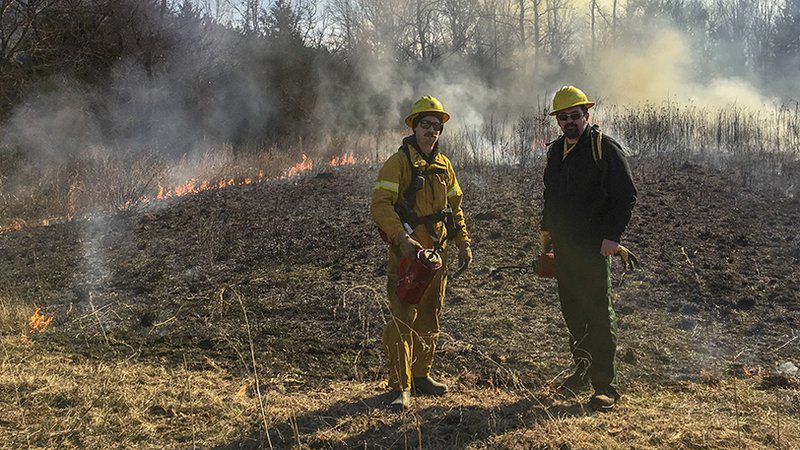AGFC and AFC partner with local landowner to benefit habitat through prescribed fire
ON 02-20-2019

Feb. 20, 2019
Randy Zellers
Assistant Chief of Communications
LITTLE ROCK — People west of Little Rock may have seen smoke plumes in the air over local landowner Ray Vogelpohl’s land near the Perry-Pulaski county line, but the small flames producing that smoke were a good thing for the future of wildlife on Vogelpohl’s property. Thanks to a partnership between Vogelpohl’s, the Arkansas Game and Fish Commission and the Arkansas Forestry Commission, the 24-acre burn was conducted safely and efficiently, hopefully setting the stage for many more to come.
According to Jason Honey, private lands biologist for the Arkansas Game and Fish Commission, this sort of small controlled burn is fairly common among Arkansas landowners wanting to restore and maintain wildlife habitat on their property.
“Fire can knock back all the woody stems and heavy underbrush that can build up on property and stimulate annual plants that produce abundant seeds and forage for wildlife,” Honey said. “Many of our native warm-season grasses that northern bobwhite thrive in require some sort of disturbance like fire.”
Honey says Vogelpohl has most of the resources needed to conduct prescribed burns on his own, but wanted to enlist the help of AGFC and AFC to be sure he knew all the proper steps to do it correctly.
“Instead of one 24-acre burn, he could break it up into smaller 5- and 6-acre burns to keep things manageable for a smaller crew,” Honey said.
The 24 acres where the burn was conducted were only a small portion of Vogelpohl’s holdings, and is primarily used as pasture land for horses and cows. He also owns forested acreage that is in native timber production as well and has conducted many practices over the years to enhance his property for wildlife.
“The landowner has planted warm-season grasses and added buffer strips near portions of his property that border the Maumelle River as well,” said Brooks Willhoite, AFC forester for Perry and Pulaski counties. “In addition to creating food and ground cover for native wildlife such as quail, he has helped benefit the water quality of the Maumelle River, which flows into Lake Maumelle, the water-supply reservoir for much of central Arkansas.”
Willhoite says the Forestry Commission works with many landowners to conduct these sorts of prescribed burns as part of an overall management plan, just as private lands biologists from the AGFC do, but they focus mainly on forested lands.
“Fire is still one of the most efficient and cost-effective ways to create and regulate wildlife habitat when done properly,” said Willhoite. “It’s only about $32 per acre for us to conduct burns like this, and that includes all of the technical assistance, planning for weather, materials and heavy equipment needed to create firebreaks and prevent the fire from escaping.”
Honey says the burn is an ideal example of how AGFC private lands biologists and county foresters work together to accomplish much more than either could do on their own.
“Both agencies are here to benefit natural resources, we just cover different facets of the bigger picture,” Honey said. “But the desired result is very similar, and when we work together, we can do a lot more for a lot less cost.”
Recent News
Subscribe to Our Weekly Newsletter E-mails
Don’t miss another issue. Sign up now to receive the AGFC Wildlife Weekly Newsletter in your mailbox every Wednesday afternoon (Waterfowl Reports are published weekly during waterfowl season and periodically outside the season). Fishing Reports arrive on Thursdays. Fill in the following fields and hit submit. Thanks, and welcome!


